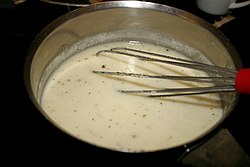Roux

Roux (/ˈruː/) is a mixture of wheat flour and fat, traditionally clarified butter. It is the thickening agent of three of the mother sauces of classical French cooking: sauce béchamel, sauce velouté, and sauce espagnole. Butter, vegetable oils, or lard are common fats used. It is used as a thickener for gravy, other sauces, soups and stews. It is typically made equal parts of flour and fat by weight. [citation needed]
Methods
The fat is heated in a pot or pan melting it if necessary, then the flour is added. The mixture is stirred until the flour is incorporated and then cooked until at least the point where a raw flour taste is no longer apparent and until desired color has been reached. The final results can range from the nearly white to the nearly black, depending on the length of time it is over the heat, and its intended use. The end result is a thickening and flavoring agent.
Roux is most often made with clarified butter as the fat base but it may be made with any edible fat. In the case of meat gravies, they are often made with rendered fat from the meat. In regional American cuisine, bacon is sometimes fried to produce fat to use in the roux. Vegetable oil is often used when producing dark roux as it does not burn at high temperatures like butter will.
When combining roux with water-based liquids, such as broth or milk, it is important that these liquids are not excessively hot. It is preferable to add room temperature or warm liquid into a moderately hot or warm roux. They should be added in small quantities to the roux while stirring, to ensure proper mixing. Otherwise, the mixture will be very lumpy, not homogeneous, and not properly thickened.
Cooks can cheat by adding a mixture of water and wheat flour to a dish which needs thickening since the heat of boiling water will release the starch from the flour, however this temperature is not high enough to eliminate the floury taste. A mixture of water and flour used in this way is colloquially known as "cowboy roux" and in modern cuisine it is called a white wash but is used infrequently since it imparts a flavor to the finished dish that a traditional haute cuisine chef would consider unacceptable. Cornflour can be used instead of wheat flour, as less is needed to thicken, and it imparts less of the raw flour taste.
Types
Light (or "white") roux provides little flavor other than a characteristic richness to a dish, and is used in French cooking and some gravies or pastries throughout the world. Darker roux, sometimes referred to as "blond", "peanut-butter", or "chocolate" roux depending on the color achieved, add a distinct nutty flavor to a dish. For example, classic Swabian (southwest German) cooking uses a darker roux for its "brown broth" (braune Brühe), which, in its simplest form, consists of nothing more than lard, flour, and water, with a bay leaf and salt for seasoning. Dark roux are often made with vegetable oils--which have a higher smoke point than butter--and are used in Cajun and Creole cuisine for gumbos and stews. The darker the roux, the less thickening power it has; a chocolate roux has about one-fourth the thickening power, by weight, of a white roux. A very dark roux, just shy of burning and turning black, has a distinctly reddish color and is sometimes referred to as "brick" roux.
Alternatives
As an alternative to roux, which is high in fat and very energy-dense, some Creole chefs have experimented with toasting flour without oil in a hot pan as an addition to gumbo. Cornstarch mixed with water (slurry), arrowroot, and other agents can be used in place of roux as well. These items do not contribute to the flavor of a dish and are used solely for thickening liquids. More recently, many chefs have turned to a group of naturally occurring chemicals known as hydrocolloids. In addition to being flavorless and possessing the ability to act as a thickening agent, the resulting texture is often superior, and only a small amount is required for the desired effect.
See also
References
External links
- Roux recipe with photo at RealCajunRecipes.com
- Sauce Recipes at RecipeOmnibus.com
- How to make roux: photo-essay
- Free Culinary School Podcast Episode 9 A podcast that talks about the proper classical technique for making a roux and what type of roux you need for specific sauces.
